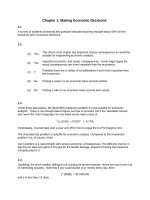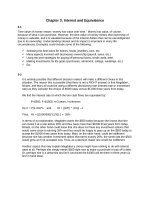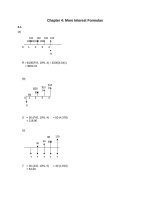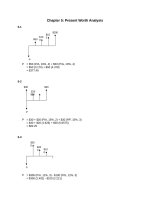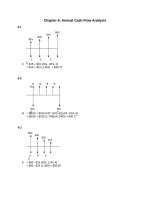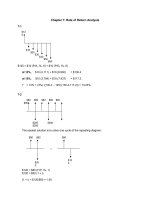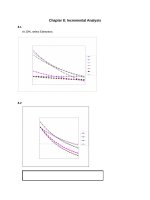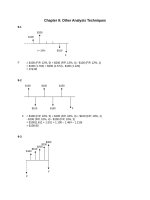Solution manual engineering mechanics dynamics 12th edition chapter 16
Bạn đang xem bản rút gọn của tài liệu. Xem và tải ngay bản đầy đủ của tài liệu tại đây (28.96 MB, 128 trang )
91962_06_s16_p0513-0640
6/8/09
2:09 PM
Page 513
© 2010 Pearson Education, Inc., Upper Saddle River, NJ. All rights reserved. This material is protected under all copyright laws as they currently
exist. No portion of this material may be reproduced, in any form or by any means, without permission in writing from the publisher.
•16–1. A disk having a radius of 0.5 ft rotates with an
initial angular velocity of 2 rad>s and has a constant angular
acceleration of 1 rad>s2. Determine the magnitudes of the
velocity and acceleration of a point on the rim of the disk
when t = 2 s.
v = v0 + ac t;
v = 2 + 1(2) = 4 rad>s
v = rv;
Ans.
v = 0.5(4) = 2 ft>s
at = 0.5(1) = 0.5 ft>s2
at = ra ;
an = v2 r;
an = (4)2(0.5) = 8 ft>s2
a = 282 + (0.5)2 = 8.02 ft>s2
Ans.
16–2. Just after the fan is turned on, the motor gives the
blade an angular acceleration a = (20e - 0.6t) rad>s2, where t
is in seconds. Determine the speed of the tip P of one of the
blades when t = 3 s. How many revolutions has the blade
turned in 3 s? When t = 0 the blade is at rest.
1.75 ft
P
dv = a dt
t
v
dv =
L0
v = -
20e - 0.6t dt
L0
20 - 0.6t 2 t
e
= 33.3 A 1 - e - 0.6t B
0.6
0
v = 27.82 rad>s when t = 3s
Ans.
vp = vr = 27.82(1.75) = 48.7 ft>s
du = v dt
L0
33.3 A 1 - e - 0.6t B dt
t
u
du =
L0
u = 33.3 at + a
3
1
1
b e - 0.6t b 2 = 33.3c3 + a
b A e - 0.6(3) - 1 B d
0.6
0.6
0
u = 53.63 rad = 8.54 rev
Ans.
513
91962_06_s16_p0513-0640
6/8/09
2:09 PM
Page 514
© 2010 Pearson Education, Inc., Upper Saddle River, NJ. All rights reserved. This material is protected under all copyright laws as they currently
exist. No portion of this material may be reproduced, in any form or by any means, without permission in writing from the publisher.
16–3. The hook is attached to a cord which is wound
around the drum. If it moves from rest with an
acceleration of 20 ft>s2, determine the angular acceleration
of the drum and its angular velocity after the drum has
completed 10 rev. How many more revolutions will the
drum turn after it has first completed 10 rev and the hook
continues to move downward for 4 s?
2 ft
a ϭ 20 ft/s2
Angular Motion: The angular acceleration of the drum can be determine by
applying Eq. 16–11.
at = ar;
20 = a(2)
a = 10.0 rad>s2
Ans.
Applying Eq. 16–7 with ac = a = 10.0 rad>s2 and u = (10 rev) * a
2p rad
b
1 rev
= 20p rad, we have
v2 = v20 + 2ac (u - u0)
v2 = 0 + 2(10.0)(20p - 0)
Ans.
v = 35.45 rad>s = 35.4 rad>s
The angular displacement of the drum 4 s after it has completed 10 revolutions can
be determined by applying Eq. 16–6 with v0 = 35.45 rad>s.
u = u0 + v0 t +
1
a t2
2 c
= 0 + 35.45(4) +
1
(10.0) A 42 B
2
= (221.79 rad) * a
1 rev
b = 35.3rev
2p rad
Ans.
514
91962_06_s16_p0513-0640
6/8/09
2:10 PM
Page 515
© 2010 Pearson Education, Inc., Upper Saddle River, NJ. All rights reserved. This material is protected under all copyright laws as they currently
exist. No portion of this material may be reproduced, in any form or by any means, without permission in writing from the publisher.
*16–4. The torsional pendulum (wheel) undergoes
oscillations in the horizontal plane, such that the angle of
rotation, measured from the equilibrium position, is given
by u = (0.5 sin 3t) rad, where t is in seconds. Determine the
maximum velocity of point A located at the periphery of
the wheel while the pendulum is oscillating. What is the
acceleration of point A in terms of t?
Angular Velocity: Here, u = (0.5 sin 3t) rad>s. Applying Eq. 16–1, we have
v =
du
= (1.5 cos 3t) rad>s
dt
By observing the above equation, the angular velocity is maximum if cos 3t = 1.
Thus, the maximum angular velocity is vmax = 1.50 rad>s. The maximum speed of
point A can be obtained by applying Eq. 16–8.
(yA)max = vmax r = 1.50(2) = 3.00 ft>s
2 ft
u
A
Ans.
Angular Acceleration: Applying Eq. 16–2, we have
a =
dv
= (-4.5 sin 3t) rad>s2
dt
The tangential and normal components of the acceleration of point A can be
determined using Eqs. 16–11 and 16–12, respectively.
at = ar = (-4.5 sin 3t)(2) = (-9 sin 3t) ft>s2
an = v2 r = (1.5 cos 3t)2 (2) = A 4.5 cos2 3t B ft>s2
Thus,
aA =
A -9 sin 3tut + 4.5 cos2 3tun B ft>s2
Ans.
•16–5. The operation of reverse gear in an automotive
transmission is shown. If the engine turns shaft A at
vA = 40 rad>s, determine the angular velocity of the drive
shaft, vB. The radius of each gear is listed in the figure.
G
vB
H
vA ϭ 40 rad/s
D
A
B
C
rA vA = rC vC :
80(40) = 40vC
vE rE = vD rD :
vE(50) = 80(40)
vE = vF = 64 rad>s
vF rF = vB rB :
64(70) = vB (50)
vB = 89.6 rad>s
vC = vD = 80 rad>s
F
vB = 89.6 rad>s
Ans.
515
E
rG ϭ 80 mm
rC ϭ rD ϭ 40 mm
rE ϭ rH ϭ 50 mm
rF ϭ 70 mm
91962_06_s16_p0513-0640
6/8/09
2:10 PM
Page 516
© 2010 Pearson Education, Inc., Upper Saddle River, NJ. All rights reserved. This material is protected under all copyright laws as they currently
exist. No portion of this material may be reproduced, in any form or by any means, without permission in writing from the publisher.
16–6. The mechanism for a car window winder is shown in
the figure. Here the handle turns the small cog C, which
rotates the spur gear S, thereby rotating the fixed-connected
lever AB which raises track D in which the window rests.
The window is free to slide on the track. If the handle is
wound at 0.5 rad>s, determine the speed of points A and E
and the speed vw of the window at the instant u = 30°.
vw
D
20 mm
0.5 rad/s
C
A
50 mm
SB
200 mm
F
vC = vC rC = 0.5(0.02) = 0.01 m>s
vS =
u
E
200 mm
vC
0.01
=
= 0.2 rad>s
rS
0.05
vA = vE = vS rA = 0.2(0.2) = 0.04 m>s = 40 mm>s
Ans.
Points A and E move along circular paths. The vertical component closes the
window.
vw = 40 cos 30° = 34.6 mm>s
Ans.
16–7. The gear A on the drive shaft of the outboard motor
has a radius rA = 0.5 in. and the meshed pinion gear B on the
propeller shaft has a radius rB = 1.2 in. Determine the
angular velocity of the propeller in t = 1.5 s, if the drive shaft
rotates with an angular acceleration a = (400t3) rad>s2,
where t is in seconds. The propeller is originally at rest and
the motor frame does not move.
A
2.20 in.
P
Angular Motion: The angular velocity of gear A at t = 1.5 s must be determined
first. Applying Eq. 16–2, we have
dv = adt
1.5 s
vA
L0
dv =
L0
400t3 dt
s
vA = 100t4 |1.5
= 506.25 rad>s
0
However, vA rA = vB rB where vB is the angular velocity of propeller. Then,
vB =
rA
0.5
b(506.25) = 211 rad>s
vA = a
rB
1.2
Ans.
516
B
91962_06_s16_p0513-0640
6/8/09
2:10 PM
Page 517
© 2010 Pearson Education, Inc., Upper Saddle River, NJ. All rights reserved. This material is protected under all copyright laws as they currently
exist. No portion of this material may be reproduced, in any form or by any means, without permission in writing from the publisher.
*16–8. For the outboard motor in Prob. 16–7, determine
the magnitude of the velocity and acceleration of point P
located on the tip of the propeller at the instant t = 0.75 s.
A
2.20 in.
P
Angular Motion: The angular velocity of gear A at t = 0.75 s must be determined
first. Applying Eq. 16–2, we have
dv = adt
0.75 s
vA
L0
dv =
L0
400t3 dt
s
vA = 100t4 |0.75
= 31.64 rad>s
0
The angular acceleration of gear A at t = 0.75 s is given by
aA = 400 A 0.753 B = 168.75 rad>s2
However, vA rA = vB rB and aA rA = aB rB where vB and aB are the angular
velocity and acceleration of propeller. Then,
vB =
aB =
rA
0.5
v = a
b(31.64) = 13.18 rad>s
rB A
1.2
rA
0.5
a = a
b (168.75) = 70.31 rad>s2
rB A
1.2
Motion of P: The magnitude of the velocity of point P can be determined using
Eq. 16–8.
yP = vB rP = 13.18 a
2.20
b = 2.42 ft>s
12
Ans.
The tangential and normal components of the acceleration of point P can be
determined using Eqs. 16–11 and 16–12, respectively.
ar = aB rP = 70.31 a
2.20
b = 12.89 ft>s2
12
an = v2B rP = A 13.182 B a
2.20
b = 31.86 ft>s2
12
The magnitude of the acceleration of point P is
aP = 2a2r + a2n = 212.892 + 31.862 = 34.4 ft>s2
Ans.
517
B
91962_06_s16_p0513-0640
6/8/09
2:10 PM
Page 518
© 2010 Pearson Education, Inc., Upper Saddle River, NJ. All rights reserved. This material is protected under all copyright laws as they currently
exist. No portion of this material may be reproduced, in any form or by any means, without permission in writing from the publisher.
•16–9. When only two gears are in mesh, the driving gear
A and the driven gear B will always turn in opposite
directions. In order to get them to turn in the same
direction an idler gear C is used. In the case shown,
determine the angular velocity of gear B when t = 5 s, if
gear A starts from rest and has an angular acceleration of
aA = (3t + 2) rad>s2, where t is in seconds.
B
75 mm
C
A
50 mm
50 mm
Idler gear
Driving gear
aA
dv = a dt
t
vA
L0
dvA =
L0
(3t + 2) dt
vA = 1.5t2 + 2t|t = 5 = 47.5 rad>s
(47.5)(50) = vC (50)
vC = 47.5 rad>s
vB (75) = 47.5(50)
Ans.
vB = 31.7 rad>s
16–10. During a gust of wind, the blades of the windmill
are given an angular acceleration of a = (0.2u) rad>s2,
where u is in radians. If initially the blades have an angular
velocity of 5 rad>s, determine the speed of point P, located
at the tip of one of the blades, just after the blade has turned
two revolutions.
a ϭ (0.2u) rad/s2
P
2.5 ft
Angular Motion: The angular velocity of the blade can be obtained by applying
Eq. 16–4.
vdv = adu
4p
v
vdv =
L5 rad>s
L0
0.2udu
v = 7.522 rad>s
Motion of P: The speed of point P can be determined using Eq. 16–8.
Ans.
yP = vrP = 7.522(2.5) = 18.8 ft>s
518
91962_06_s16_p0513-0640
6/8/09
2:11 PM
Page 519
© 2010 Pearson Education, Inc., Upper Saddle River, NJ. All rights reserved. This material is protected under all copyright laws as they currently
exist. No portion of this material may be reproduced, in any form or by any means, without permission in writing from the publisher.
16–11. The can opener operates such that the can is driven
by the drive wheel D. If the armature shaft S on the motor
turns with a constant angular velocity of 40 rad>s,
determine the angular velocity of the can. The radii of S, can
P, drive wheel D, gears A, B, and C, are rS = 5 mm,
rP = 40 mm, rD = 7.5 mm, rA = 20 mm, rB = 10 mm, and
rC = 25 mm, respectively.
D
C
P
B
Gears A and B will have the same angular velocity since they are mounted on the
same axle. Thus,
A
S
vA rA = vs rs
vB = vA = ¢
rs
5
≤ v = a b(40) = 10 rad>s
rA s
20
Wheel D is mounted on the same axle as gear C, which in turn is in mesh with
gear B.
vC rC = vB rB
vD = vC = ¢
rB
10
≤ v = a b(10) = 4 rads>s
rC B
25
Finally, the rim of can P is in mesh with wheel D.
vP rP = vD rD
vP = ¢
rD
7.5
≤ v = a b(4) = 0.75 rad>s
rP D
40
Ans.
*16–12. If the motor of the electric drill turns the
armature shaft S with a constant angular acceleration of
aS = 30 rad>s2, determine the angular velocity of the shaft
after it has turned 200 rev, starting from rest.
2p rad
Motion of Pulley A: Here, us = (200 rev)a
b = 400p rad. Since the angular
1 rev
acceleration of shaft s is constant, its angular velocity can be determined from
vs 2 = (vs)0 2 + 2aC C us - (us)0 D
vs 2 = 02 + 2(30)(400p - 0)
vs = 274.6 rad>s
Ans.
519
S
91962_06_s16_p0513-0640
6/8/09
2:11 PM
Page 520
© 2010 Pearson Education, Inc., Upper Saddle River, NJ. All rights reserved. This material is protected under all copyright laws as they currently
exist. No portion of this material may be reproduced, in any form or by any means, without permission in writing from the publisher.
•16–13. If the motor of the electric drill turns the armature
shaft S with an angular velocity of vS = (100t1>2) rad>s,
determine the angular velocity and angular acceleration of
the shaft at the instant it has turned 200 rev, starting from rest.
S
2prad
Motion of Armature Shaft S: Here, us = (200 rev)a
b = 400p. The angular
1 rev
velocity of A can be determined from
L
dus =
L
t
us
L0
vsdt
us =
L0
100t1>2dt
2
t
us|u0s = 66.67t3>2 0
us = A 66.67t3>2 B rad
When us = 400p rad,
400p = 66.67t3>2
t = 7.083 s
Thus, the angular velocity of the shaft after it turns 200 rev (t = 7.083 s) is
vs = 100(7.083)1>2 = 266 rad>s
Ans.
The angular acceleration of the shaft is
as =
dvs
1
50
= 100a t - 1>2 b = a 1>2 b rad>s2
dt
2
t
When t = 7.083 s,
as =
50
7.0831>2
= 18.8 rad>s2
Ans.
520
91962_06_s16_p0513-0640
6/8/09
2:11 PM
Page 521
© 2010 Pearson Education, Inc., Upper Saddle River, NJ. All rights reserved. This material is protected under all copyright laws as they currently
exist. No portion of this material may be reproduced, in any form or by any means, without permission in writing from the publisher.
16–14. A disk having a radius of 6 in. rotates about a fixed
axis with an angular velocity of v = (2t + 3) rad>s, where t is
in seconds. Determine the tangential and normal components
of acceleration of a point located on the rim of the disk at the
instant the angular displacement is u = 40 rad.
Motion of the Disk: We have
du =
L
t
u
du =
L0
vdt
L
L0
(2t + 3)dt
u
u ƒ 0 = A t2 + 3t B 2
t
0
u = A t2 + 3t B rad
When u = 40 rad,
40 = t2 + 3t
t2 + 3t - 40 = 0
Solving for the positive root,
t = 5s
Also,
a =
dv
= 2 rad>s2
dt
When t = 5 s(u = 40 rad),
v = 2(5) + 3 = 13 rad>s
Motion of Point P: Using the result for v and a, the tangential and normal
components of the acceleration of point P are
at = arp = 2 a
6
b = 1 ft>s2
12
an = v2 rp = (13)2 a
Ans.
6
b = 84.5 ft>s2
12
Ans.
521
91962_06_s16_p0513-0640
6/8/09
2:12 PM
Page 522
© 2010 Pearson Education, Inc., Upper Saddle River, NJ. All rights reserved. This material is protected under all copyright laws as they currently
exist. No portion of this material may be reproduced, in any form or by any means, without permission in writing from the publisher.
16–15. The 50-mm-radius pulley A of the clothes
dryer rotates with an angular acceleration of
2
aA = (27u1>2
A ) rad>s , where uA is in radians. Determine its
angular acceleration when t = 1 s, starting from rest.
Motion of Pulley A: The angular velocity of pulley A can be determined from
L
vA dvA =
L
vA
L0
aA duA
uA
vAdvA =
L0
50 mm
27uA 1>2duA
vA 2 vA
2 = 18uA 3>2Ηu0A
2 0
vA = A 6uA 3>4 B rad>s
Using this result, the angular displacement of A as a function of t can be
determined from
L
dt =
t
L0
duA
L vA
uA
dt =
t|t0 =
duA
L0 6uA 3>4
2 1>4 2 uA
u
3 A
0
2
t = a uA 1>4 b s
3
3 4
uA = a t b rad
2
When t = 1 s
4
3
uA = c (1) d = 5.0625 rad
2
Thus, when t = 1 s, aA is
aA = 27 A 5.06251>2 B = 60.8 rad>s2
Ans.
522
A
91962_06_s16_p0513-0640
6/8/09
2:12 PM
Page 523
© 2010 Pearson Education, Inc., Upper Saddle River, NJ. All rights reserved. This material is protected under all copyright laws as they currently
exist. No portion of this material may be reproduced, in any form or by any means, without permission in writing from the publisher.
*16–16. If the 50-mm-radius motor pulley A of the clothes
dryer rotates with an angular acceleration of
aA = (10 + 50t) rad>s2, where t is in seconds, determine its
angular velocity when t = 3 s, starting from rest.
Motion of Pulley A: The angular velocity of pulley A can be determined from
L
dvA =
aAdt
L
t
vA
L0
dvA =
L0
50 mm
(10 + 50t)dt
vA|v0 A = A 10t + 25t2 B
vA = A 10t + 25t2 B rad>s
2
A
t
0
When t = 3 s
vA = 10(3) + 25 A 32 B = 225 rad>s
Ans.
•16–17. The vacuum cleaner’s armature shaft S rotates
with an angular acceleration of a = 4v3>4 rad>s2, where v is
in rad>s. Determine the brush’s angular velocity when
t = 4 s, starting from rest.The radii of the shaft and the brush
are 0.25 in. and 1 in., respectively. Neglect the thickness of the
drive belt.
Motion of the Shaft: The angular velocity of the shaft can be determined from
dvS
L aS
dt =
L
t
L0
2
dt =
vs
A
dvS
L0 4vS 3>4
t
2
vs
t 0 = vS 1>4 0
t = vS 1>4
vS = A t4 B rad>s
When t = 4 s
vs = 44 = 256 rad>s
Motion of the Beater Brush: Since the brush is connected to the shaft by a non-slip
belt, then
vB rB = vs rs
vB = ¢
rs
0.25
b(256) = 64 rad>s
≤v = a
rB s
1
Ans.
523
S
A
S
91962_06_s16_p0513-0640
6/8/09
2:12 PM
Page 524
© 2010 Pearson Education, Inc., Upper Saddle River, NJ. All rights reserved. This material is protected under all copyright laws as they currently
exist. No portion of this material may be reproduced, in any form or by any means, without permission in writing from the publisher.
16–18. Gear A is in mesh with gear B as shown. If A starts
from rest and has a constant angular acceleration of
aA = 2 rad>s2, determine the time needed for B to attain an
angular velocity of vB = 50 rad>s.
rA ϭ 25 mm
rB ϭ 100 mm
A
Angular Motion: The angular acceleration of gear B must be determined first. Here,
aA rA = aB rB. Then,
aB =
a
rA
25
a = a
b(2) = 0.5 rad>s2
rB A
100
The time for gear B to attain an angular velocity of vB = 50 rad>s can be obtained
by applying Eq. 16–5.
vB = (v0)B + aB t
50 = 0 + 0.5t
t = 100 s
Ans.
524
B
91962_06_s16_p0513-0640
6/8/09
2:12 PM
Page 525
© 2010 Pearson Education, Inc., Upper Saddle River, NJ. All rights reserved. This material is protected under all copyright laws as they currently
exist. No portion of this material may be reproduced, in any form or by any means, without permission in writing from the publisher.
16–19. The vertical-axis windmill consists of two blades
that have a parabolic shape. If the blades are originally at
rest and begin to turn with a constant angular acceleration
of ac = 0.5 rad>s2, determine the magnitude of the velocity
and acceleration of points A and B on the blade after the
blade has rotated through two revolutions.
ac ϭ 0.5 rad/s2
Angular Motion: The angular velocity of the blade after the blade has rotated
2(2p) = 4p rad can be obtained by applying Eq. 16–7.
v2 = v20 + 2ac (u - u0)
B
10 ft
20 ft
v2 = 02 + 2(0.5)(4p - 0)
v = 3.545 rad>s
Motion of A and B: The magnitude of the velocity of point A and B on the blade can
be determined using Eq. 16–8.
yA = vrA = 3.545(20) = 70.9 ft>s
Ans.
vB = vrB = 3.545(10) = 35.4 ft>s
Ans.
The tangential and normal components of the acceleration of point A and B can be
determined using Eqs. 16–11 and 16–12 respectively.
(at)A = arA = 0.5(20) = 10.0 ft>s2
(an)A = v2 rA = A 3.5452 B (20) = 251.33 ft>s2
(at)B = arB = 0.5(10) = 5.00 ft>s2
(an)B = v2 rB = A 3.5452 B (10) = 125.66 ft>s2
The magnitude of the acceleration of points A and B are
(a)A = 2(at)2A + (an)2A = 210.02 + 251.332 = 252 ft>s2
Ans.
(a)B = = 2(at)2B + (an)2B = 25.002 + 125.662 = 126 ft>s2
Ans.
525
A
91962_06_s16_p0513-0640
6/8/09
2:13 PM
Page 526
© 2010 Pearson Education, Inc., Upper Saddle River, NJ. All rights reserved. This material is protected under all copyright laws as they currently
exist. No portion of this material may be reproduced, in any form or by any means, without permission in writing from the publisher.
*16–20. The vertical-axis windmill consists of two blades
that have a parabolic shape. If the blades are originally at rest
and begin to turn with a constant angular acceleration of
ac = 0.5 rad>s2, determine the magnitude of the velocity and
acceleration of points A and B on the blade when t = 4 s.
ac ϭ 0.5 rad/s2
Angular Motion: The angular velocity of the blade at t = 4 s can be obtained by
applying Eq. 16–5.
B
10 ft
v = v0 + ac t = 0 + 0.5(4) = 2.00 rad>s
20 ft
A
Motion of A and B: The magnitude of the velocity of points A and B on the blade
can be determined using Eq. 16–8.
yA = vrA = 2.00(20) = 40.0 ft>s
Ans.
yB = vrB = 2.00(10) = 20.0 ft>s
Ans.
The tangential and normal components of the acceleration of points A and B can be
determined using Eqs. 16–11 and 16–12 respectively.
(at)A = arA = 0.5(20) = 10.0 ft>s2
(an)A = v2 rA = A 2.002 B (20) = 80.0 ft>s2
(at)B = arB = 0.5(10) = 5.00 ft>s2
(an)B = v2 rB = A 2.002 B (10) = 40.0 ft>s2
The magnitude of the acceleration of points A and B are
(a)A = 2(at)2A + (an)2A = 210.02 + 80.02 = 80.6 ft>s2
Ans.
(a)B = 2(at)2B + (an)2B = 25.002 + 40.02 = 40.3 ft>s2
Ans.
V0 ϭ 8 rad/s
16.21. The disk is originally rotating at v0 = 8 rad>s. If it is
subjected to a constant angular acceleration of a = 6 rad>s2,
determine the magnitudes of the velocity and the n and t
components of acceleration of point A at the instant
t = 0.5 s.
B
1.5 ft
2 ft
v = v0 + ac t
v = 8 + 6(0.5) = 11 rad>s
v = rv;
vA = 2(11) = 22 ft>s
Ans.
at = ra;
(aA)t = 2(6) = 12.0 ft>s2
Ans.
an = v2r;
(aA)n = (11)2(2) = 242 ft>s2
Ans.
526
A
91962_06_s16_p0513-0640
6/8/09
2:13 PM
Page 527
© 2010 Pearson Education, Inc., Upper Saddle River, NJ. All rights reserved. This material is protected under all copyright laws as they currently
exist. No portion of this material may be reproduced, in any form or by any means, without permission in writing from the publisher.
V0 ϭ 8 rad/s
16–22. The disk is originally rotating at v0 = 8 rad>s. If it
is subjected to a constant angular acceleration of
a = 6 rad>s2, determine the magnitudes of the velocity and
the n and t components of acceleration of point B just after
the wheel undergoes 2 revolutions.
B
1.5 ft
2 ft
2
v =
v20
+ 2ac (u - u0)
v2 = (8)2 + 2(6)[2(2p) - 0]
v = 14.66 rad>s
vB = vr = 14.66(1.5) = 22.0 ft>s
Ans.
(aB)t = ar = 6(1.5) = 9.00 ft>s2
Ans.
(aB)n = v2r = (14.66)2(1.5) = 322 ft>s2
Ans.
16–23. The blade C of the power plane is driven by pulley
A mounted on the armature shaft of the motor. If the
constant angular acceleration of pulley A is aA = 40 rad>s2,
determine the angular velocity of the blade at the instant A
has turned 400 rev, starting from rest.
A
25 mm
C
B
75 mm
Motion of Pulley A: Here, uA = (400 rev)a
2p rad
b = 800p rad. Since the angular
1 rev
velocity can be determined from
vA 2 = (vA)0 2 + 2aC C uA - (uA)0 D
vA 2 = 02 + 2(40)(800p - 0)
vA = 448.39 rad>s
Motion of Pulley B: Since blade C and pulley B are on the same axle, both will have
the same angular velocity. Pulley B is connected to pulley A by a nonslip belt. Thus,
vB rB = vA rA
vC = vB = ¢
rA
25
≤ v = a b(448.39) = 224 rad>s
rB A
50
Ans.
527
50 mm
A
91962_06_s16_p0513-0640
6/8/09
2:14 PM
Page 528
© 2010 Pearson Education, Inc., Upper Saddle River, NJ. All rights reserved. This material is protected under all copyright laws as they currently
exist. No portion of this material may be reproduced, in any form or by any means, without permission in writing from the publisher.
*16–24. For a short time the motor turns gear A with an
angular acceleration of aA = (30t1>2) rad>s2, where t is in
seconds. Determine the angular velocity of gear D when
t = 5 s, starting from rest. Gear A is initially at rest.The radii
of gears A, B, C, and D are rA = 25 mm, rB = 100 mm,
rC = 40 mm, and rD = 100 mm, respectively.
A
C
Motion of the Gear A: The angular velocity of gear A can be determined from
dvA =
L
L
t
vA
dvA =
L0
vA
adt
L0
vA Η0 = 20t3>2 2
30t1>2dt
t
0
vA = A 20t3>2 B rad>s
When t = 5 s
vA = 20 A 53>2 B = 223.61 rad>s
Motion of Gears B, C, and D: Gears B and C which are mounted on the same axle
will have the same angular velocity. Since gear B is in mesh with gear A, then
vB rB = vA rA
vC = vB = ¢
rA
25
b(223.61) = 55.90 rad>s
≤v = a
rB A
100
Also, gear D is in mesh with gear C. Then
vD rD = vC rC
vD = ¢
rC
40
b (55.90) = 22.4 rad>s
≤v = a
rD C
100
Ans.
528
B
D
91962_06_s16_p0513-0640
6/8/09
2:14 PM
Page 529
© 2010 Pearson Education, Inc., Upper Saddle River, NJ. All rights reserved. This material is protected under all copyright laws as they currently
exist. No portion of this material may be reproduced, in any form or by any means, without permission in writing from the publisher.
•16–25. The motor turns gear A so that its angular velocity
increases uniformly from zero to 3000 rev>min after the shaft
turns 200 rev. Determine the angular velocity of gear D when
t = 3 s. The radii of gears A, B, C, and D are rA = 25 mm,
rB = 100 mm, rC = 40 mm, and rD = 100 mm, respectively.
Motion of Wheel A: Here, vA = a3000
A
rev
1 min 2p rad
ba
ba
b = 100p rad>s
min
60 s
1rev
2p rad
b = 400p rad. Since the angular acceleration of gear
1 rev
A is constant, it can be determined from
when uA = (200 rev)a
vA 2 = (vA)0 2 + 2aA C uA - (uA)0 D
(100p)2 = 02 + 2aA (400p - 0)
aA = 39.27 rad>s2
Thus, the angular velocity of gear A when t = 3 s is
vA = A vA B 0 + aA t
= 0 + 39.27(3)
= 117.81 rad>s
Motion of Gears B, C, and D: Gears B and C which are mounted on the same axle
will have the same angular velocity. Since gear B is in mesh with gear A, then
vB rB = vB rA
vC = vB = ¢
rA
25
b(117.81) = 29.45 rad>s
≤v = a
rB A
100
Also, gear D is in mesh with gear C. Then
vD rD = vC rC
vD = ¢
rC
40
b (29.45) = 11.8 rad>s
≤v = a
rD C
100
Ans.
529
C
B
D
91962_06_s16_p0513-0640
6/8/09
2:14 PM
Page 530
© 2010 Pearson Education, Inc., Upper Saddle River, NJ. All rights reserved. This material is protected under all copyright laws as they currently
exist. No portion of this material may be reproduced, in any form or by any means, without permission in writing from the publisher.
16–26. Rotation of the robotic arm occurs due to linear
movement of the hydraulic cylinders A and B. If this motion
causes the gear at D to rotate clockwise at 5 rad>s, determine
the magnitude of velocity and acceleration of the part C
held by the grips of the arm.
4 ft
2 ft
45Њ
Motion of Part C: Since the shaft that turns the robot’s arm is attached to gear D,
then the angular velocity of the robot’s arm vR = vD = 5.00 rad>s. The distance of
part C from the rotating shaft is rC = 4 cos 45° + 2 sin 45° = 4.243 ft. The
magnitude of the velocity of part C can be determined using Eq. 16–8.
yC = vR rC = 5.00(4.243) = 21.2 ft>s
D
B
Ans.
The tangential and normal components of the acceleration of part C can be
determined using Eqs. 16–11 and 16–12 respectively.
at = arC = 0
an = v2R rC = A 5.002 B (4.243) = 106.07 ft>s2
The magnitude of the acceleration of point C is
aC = 2a2t + a2n = 202 + 106.072 = 106 ft>s2
Ans.
530
A
C
3 ft
91962_06_s16_p0513-0640
6/8/09
2:15 PM
Page 531
© 2010 Pearson Education, Inc., Upper Saddle River, NJ. All rights reserved. This material is protected under all copyright laws as they currently
exist. No portion of this material may be reproduced, in any form or by any means, without permission in writing from the publisher.
16–27. For a short time, gear A of the automobile
starter rotates with an angular acceleration of
aA = (450t2 + 60) rad>s2, where t is in seconds. Determine
the angular velocity and angular displacement of gear B
when t = 2 s, starting from rest. The radii of gears A and B
are 10 mm and 25 mm, respectively.
A
B
Motion of Gear A: Applying the kinematic equation of variable angular
acceleration,
L
dvA
t
vA
dvA =
L0
aAdt
L
L0
A 450t2 + 60 B dt
vA
vAΗ0 = 150t3 + 60t 2
t
0
vA = A 150t3 + 60t B rad>s
When t = 2 s,
vA = 150(2)3 + 60(2) = 1320 rad>s
duA =
L
t
uA
L0
duA =
L0
vA dt
L
A 150t3 + 60t B dt
uAΗ0 = 37.5t4 + 30t2 2
uA
uA = A 37.5t + 30t
4
2
t
0
B rad
When t = 2 s
uA = 37.5(2)4 + 30(2)2 = 720 rad
Motion of Gear B: Since gear B is meshed with gear A, Fig. a, then
vp = vA rA = vB rB
vB = vA ¢
rA
≤
rB
= (1320) ¢
0.01
≤
0.025
Ans.
= 528 rad>s
uB = uA ¢
rA
≤
rB
= 720 ¢
0.01
≤
0.025
= 288 rad
Ans.
531
91962_06_s16_p0513-0640
6/8/09
2:15 PM
Page 532
© 2010 Pearson Education, Inc., Upper Saddle River, NJ. All rights reserved. This material is protected under all copyright laws as they currently
exist. No portion of this material may be reproduced, in any form or by any means, without permission in writing from the publisher.
*16–28. For a short time, gear A of the automobile starter
rotates with an angular acceleration of aA = (50v1>2) rad>s2,
where v is in rad>s. Determine the angular velocity of gear B
after gear A has rotated 50 rev, starting from rest. The radii of
gears A and B are 10 mm and 25 mm, respectively.
A
B
Motion of Gear A: We have
L
dvA
L aA
dt =
t
L0
vA
dt =
t
tΗ0 =
dvA
L0
50vA 1>2
vA
1
vA 1>2 2
25
0
vA = A 625t2 B rad>s
The angular displacement of gear A can be determined using this result.
duA =
L
t
uA
L0
duA =
vA dt
L
L0
A 625t2 B dt
uAΗ0 = 208.33t3 2
uA
t
0
uA = A 208.33t3 B rad
When uA = 50 reva
2p rad
b = 100p rad,
1 rev
100p = 208.33t3
t = 1.147 s
Thus, the angular velocity of gear A at t = 1.147 s(uA = 100p rad) is
vA = 625(1.1472) = 821.88 rad>s
Motion of Gear B: Since gear B is meshed with gear A, Fig. a, then
vp = vA rA = vB rB
vB = vA ¢
rA
≤
rB
= 821.88a
0.01
b
0.025
= 329 rad>s
Ans.
532
91962_06_s16_p0513-0640
6/8/09
2:15 PM
Page 533
© 2010 Pearson Education, Inc., Upper Saddle River, NJ. All rights reserved. This material is protected under all copyright laws as they currently
exist. No portion of this material may be reproduced, in any form or by any means, without permission in writing from the publisher.
•16–29. Gear A rotates with a constant angular velocity of
vA = 6 rad>s. Determine the largest angular velocity of
gear B and the speed of point C.
C
100 mm
vB
(rB)max = (rA)max = 50 22 mm
vA ϭ 6 rad/s
100 mm
(rB)min = (rA)min = 50 mm
B
A
100 mm
100 mm
When rA is max., rB is min.
vB (rB) = vA rA
(vB)max = 6a
rA
50 22
b = 6¢
≤
rB
50
(vB)max = 8.49 rad>s
Ans.
vC = (vB)max rC = 8.49 A 0.05 22 B
vC = 0.6 m>s
Ans.
16–30. If the operator initially drives the pedals at
20 rev>min, and then begins an angular acceleration of
30 rev>min2, determine the angular velocity of the flywheel
F when t = 3 s. Note that the pedal arm is fixed connected
to the chain wheel A, which in turn drives the sheave B
using the fixed connected clutch gear D. The belt wraps
around the sheave then drives the pulley E and fixedconnected flywheel.
A
E
F
D
B
v = v0 + ac t
vA = 20 + 30 a
3
b = 21.5 rev>min
60
rA ϭ 125 mm
rD ϭ 20 mm
vA rA = vD rD
21.5(125) = vD (20)
vD = vB = 134.375
vB rB = vE rE
134.375(175) = vE(30)
vE = 783.9 rev>min
Ans.
vF = 784 rev>min
533
rB ϭ 175 mm
rE ϭ 30 mm
91962_06_s16_p0513-0640
6/8/09
2:16 PM
Page 534
© 2010 Pearson Education, Inc., Upper Saddle River, NJ. All rights reserved. This material is protected under all copyright laws as they currently
exist. No portion of this material may be reproduced, in any form or by any means, without permission in writing from the publisher.
16–31. If the operator initially drives the pedals at
12 rev>min, and then begins an angular acceleration of
8 rev>min2, determine the angular velocity of the flywheel
F after the pedal arm has rotated 2 revolutions. Note that
the pedal arm is fixed connected to the chain wheel A,
which in turn drives the sheave B using the fixedconnected clutch gear D. The belt wraps around the sheave
then drives the pulley E and fixed-connected flywheel.
A
E
F
D
B
v2 = v20 + 2ac (u - u0)
rA ϭ 125 mm
rD ϭ 20 mm
v2 = (12)2 + 2(8)(2 - 0)
v = 13 266 rev>min
vA rA = vD rD
13 266(125) = vD (20)
vD = vD = 82.916
vB rB = vE rE
82.916(175) = vE(30)
vE = 483.67
vF = 484 rev>min
Ans.
534
rB ϭ 175 mm
rE ϭ 30 mm
91962_06_s16_p0513-0640
6/8/09
2:16 PM
Page 535
© 2010 Pearson Education, Inc., Upper Saddle River, NJ. All rights reserved. This material is protected under all copyright laws as they currently
exist. No portion of this material may be reproduced, in any form or by any means, without permission in writing from the publisher.
*16–32. The drive wheel A has a constant angular velocity
of vA. At a particular instant, the radius of rope wound on
each wheel is as shown. If the rope has a thickness T,
determine the angular acceleration of wheel B.
B
rB
Angular Motion: The angular velocity between wheels A and B can be related by
vA rA = vB rB or vB =
rA
v
rB A
During time dt, the volume of the tape exchange between the wheel is
-2prB drB = 2prA drA
drB = - ¢
Applying Eq. 16–2 with vB =
aB =
rA
≤ drA
rB
[1]
rA
v , we have
rB A
rA drB
dvB
d rA
1 drA
=
c vA d = vA a
- 2
b
rB dt
dt
dt rB
rB dt
[2]
Substituting Eq.[1] into [2] yields
aB = vA a
r2A + r2B drA
b
dt
r3B
[3]
The volume of tape coming out from wheel A in time dt is
2prA drA = (vA rA dt) T
drA
vA T
=
dt
2p
[4]
Substitute Eq.[4] into [3] gives
aB =
v2A T
2pr3B
A r2A + r2B B
Ans.
535
A
vA
rA
91962_06_s16_p0513-0640
6/8/09
2:16 PM
Page 536
© 2010 Pearson Education, Inc., Upper Saddle River, NJ. All rights reserved. This material is protected under all copyright laws as they currently
exist. No portion of this material may be reproduced, in any form or by any means, without permission in writing from the publisher.
•16–33. If the rod starts from rest in the position shown
and a motor drives it for a short time with an angular
acceleration of a = (1.5et) rad>s2, where t is in seconds,
determine the magnitude of the angular velocity and the
angular displacement of the rod when t = 3 s. Locate the
point on the rod which has the greatest velocity and
acceleration, and compute the magnitudes of the velocity
and acceleration of this point when t = 3 s. The rod is
defined by z = 0.25 sin(py) m, where the argument for the
sine is given in radians and y is in meters.
z
z = 0.25 sin (π y)
x
1m
dv = a dt
t
v
dv =
L0
L0
1.5et dt
v = 1.5etΗt0 = 1.5 C et - 1 D
du = v dt
t
u
L0
du = 1.5
L0
y
C et - 1 D dt
u = 1.5 C et - t D t0 = 1.5 C et - t - 1 D
When t = 3 s
v = 1.5 C e3 - 1 D = 28.63 = 28.6 rad>s
Ans.
u = 1.5 C e3 - 3 - 1 D = 24.1 rad
Ans.
The point having the greatest velocity and acceleration is located furthest from the
axis of rotation. This is at y = 0.5 m, where z = 0.25 sin (p0.5) = 0.25 m.
Hence,
Ans.
vP = v(z) = 28.63(0.25) = 7.16 m>s
(at)P = a(z) = A 1.5e3 B (0.25) = 7.532 m>s2
(an)P = v2(z) = (28.63)2(0.25) = 204.89 m>s2
aP = 2(at)2P + (an)2P = 2(7.532)2 + (204.89)2
aP = 205 m>s2
Ans.
536
91962_06_s16_p0513-0640
6/8/09
2:17 PM
Page 537
© 2010 Pearson Education, Inc., Upper Saddle River, NJ. All rights reserved. This material is protected under all copyright laws as they currently
exist. No portion of this material may be reproduced, in any form or by any means, without permission in writing from the publisher.
z
16–34. If the shaft and plate rotate with a constant
angular velocity of v = 14 rad>s, determine the velocity
and acceleration of point C located on the corner of the
plate at the instant shown. Express the result in Cartesian
vector form.
v
A
0.6 m
a
0.2 m
C
D
O
0.4 m
We will first express the angular velocity v of the plate in Cartesian vector form. The
unit vector that defines the direction of v is
uOA =
3
2
6
= - i + j + k
7
7
7
2( -0.3) + 0.2 + 0.6
2
2
Thus,
3
2
6
v = vuOA = 14 a - i + j + kb = [-6i + 4j + 12k] rad>s
7
7
7
Since v is constant
a = 0
For convenience, rC = [-0.3i + 0.4j] m is chosen. The velocity and acceleration of
point C can be determined from
vC = v * rC
= ( -6i + 4j + 12k) * (-0.3i + 0.4j)
Ans.
= [-4.8i - 3.6j - 1.2k] m>s
and
aC = a * rC
= 0 + (-6i + 4j + 12k) * [(-6i + 4j + 12k) * (-0.3i + 0.4j)]
= [38.4i - 64.8j + 40.8k]m>s2
Ans.
537
x
0.4 m
B
-0.3i + 0.2j + 0.6k
2
0.3 m
0.3 m
y
